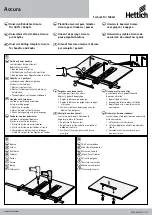
Additional Safety Rules For Drill Presses:
General Assembly Instructions:
Round - Out Tolerance:
Operation Directions:
a. Be sure drill bit or cutting tool is securely locked in the chuck.
b. Be sure chuck key is removed from the chuck before turning on power.
c. Adjust the table or depth stop to avoid drilling into the table.
d. Shut off the power, remove the drill bit on cutting tool, and clean the table before leaving
the machine.
e. Caution when practical. Use clamps or a vise to secure work piece to keep the work
piece from rotating with the drill bit or cutting tool.
plug it fits a grounding receptacle when using an adapter to connect a three prong plug to a two
prong receptacle. The adapter plug must be attacked to a permanent ground.
2
Warning: Do not Wear Gloves While Operating Presses
Screw column to base, assemble press head to column and tighten set screw with hex key. Attach
handles chuck etc. upon completion of assembly. Drill press can be washed with kerosene to re-
move anti - rust oil applied at factory, then lubrication oil can be applied.
For drilling operations require close tolerances. Place drill blank in the chuck and check round
out with a dial indicator. If the round - out is not within desired tolerance, tap the chuck bottom
with a rubber or leather mallet until you get the desired tolerance.
The following directions will give the operator not familiar with the drill press operations a start.
Use scrap material for practice to get the feel of the machine before attempting regular work.
Correct Drilling Speeds: Factors which determine the best speed to use in any drill press opera-
tion are based on the material being worked, size of hole, type of drill or other cutter and quali-
ty of cut desired. The smaller the drill, the greater the required RPM. In soft materials, the
speed should be higher than in hard metals.
Drilling in Metal: Use clamps to hold the work when drilling in metal. The work should never
be held in the bare hand. The lips of the drill may seize the work at any time especially when
breaking through the stock. If the piece is whirled out of the operator's hand, he may be injured
in any case. The drill will be broken when the work strikes the column.
The work must be clamped firmly while drilling any tilting, twisting or shifting results not only
in a rough hole, but also increases drill breakage. For flat work, lay the piece on a wooden base
and clamp it firmly down against the table to prevent it from turning. If the piece is of its regu-
lar shape and cannot be laid flat on the table, it should be securely blocked and clamped.
Boring in Wood Twist Drills: Although intending for metal drilling may also be used for forc-
ing holes in wood, machine spur bits are generally preferred for working in wood. They cut a
square bottom hole and are designed for removal of wood chips. Do not ups hand bits which
have a screw tip. At drill press speeds they turn into the wood so rapidly as to lift the work off
the table and whirl it.
A
B
C
























